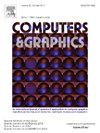Wiggle! Wiggle! Wiggle! Visualizing uncertainty in node attributes in straight-line node-link diagrams using animated wiggliness
IF 2.5
4区 计算机科学
Q2 COMPUTER SCIENCE, SOFTWARE ENGINEERING
引用次数: 0
Abstract
Uncertainty is common to most types of data, from meteorology to the biomedical sciences. Here, we are interested in the visualization of uncertainty within the context of multivariate graphs, specifically the visualization of uncertainty attached to node attributes. Many visual channels offer themselves up for the visualization of node attributes and their uncertainty. One controversial and relatively under-explored channel, however, is animation, despite its conceptual advantages. In this paper, we investigate node “wiggliness”, i.e. uncertainty-dependent pseudo-random motion of nodes, as a potential new visual channel with which to communicate node attribute uncertainty. To study wiggliness’ effectiveness, we compare it against three other visual channels identified from a thorough review of uncertainty visualization literature—namely node enclosure, node fuzziness, and node color saturation. In a larger-scale, mixed method, Prolific-crowd-sourced, online user study of 160 participants, we quantitatively and qualitatively compare these four uncertainty encodings across eight low-level graph analysis tasks that probe participants’ abilities to parse the presented networks both on an attribute and topological level. We ultimately conclude that all four uncertainty encodings appear comparably useful—as opposed to previous findings. Wiggliness may be a suitable and effective visual channel with which to communicate node attribute uncertainty, at least for the kinds of data and tasks considered in our study.

摆动!摆动!摆动!利用动画摆动可视化直线节点链接图中节点属性的不确定性
从气象学到生物医学,大多数类型的数据都存在不确定性。在这里,我们感兴趣的是多变量图上下文中的不确定性的可视化,特别是附加到节点属性的不确定性的可视化。许多可视化通道提供了对节点属性及其不确定性的可视化。然而,尽管动画具有概念上的优势,但它仍是一个有争议且开发相对较少的渠道。在本文中,我们研究了节点的“摆动”,即节点的不确定性相关的伪随机运动,作为一种潜在的新的视觉通道来传达节点属性的不确定性。为了研究摆动的有效性,我们将其与从不确定性可视化文献中确定的其他三种视觉通道进行比较,即节点框、节点模糊和节点颜色饱和度。在对160名参与者进行的大规模混合方法中,我们定量和定性地比较了这四种不确定性编码在8个低级图分析任务中的表现,这些任务考察了参与者在属性和拓扑水平上分析所呈现网络的能力。我们最终得出结论,与之前的发现相反,所有四种不确定性编码似乎都相当有用。至少对于我们研究中考虑的数据和任务来说,Wiggliness可能是一种合适而有效的可视化通道,可以用来传达节点属性的不确定性。
本文章由计算机程序翻译,如有差异,请以英文原文为准。
求助全文
约1分钟内获得全文
求助全文
来源期刊

Computers & Graphics-Uk
工程技术-计算机:软件工程
CiteScore
5.30
自引率
12.00%
发文量
173
审稿时长
38 days
期刊介绍:
Computers & Graphics is dedicated to disseminate information on research and applications of computer graphics (CG) techniques. The journal encourages articles on:
1. Research and applications of interactive computer graphics. We are particularly interested in novel interaction techniques and applications of CG to problem domains.
2. State-of-the-art papers on late-breaking, cutting-edge research on CG.
3. Information on innovative uses of graphics principles and technologies.
4. Tutorial papers on both teaching CG principles and innovative uses of CG in education.
 求助内容:
求助内容: 应助结果提醒方式:
应助结果提醒方式:


